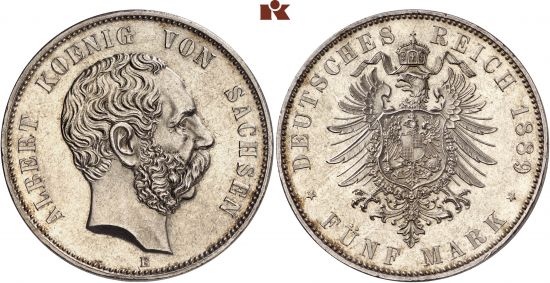Difference between revisions of "Saxony 1889-E 5 mark"
m (Text replacement - "The Muldenhutten mint, after striking coins for the Saxon kings, later minted for the Weimar republic, the Nazis and the Communists before striking coins for the unified Federal Republic of Germany." to "The Muldenhutten mint, after striking coins for the Saxon kings, later minted for the Weimar republic, the Nazis and the Communists before closing in 1953.") |
m |
||
| Line 3: | Line 3: | ||
This specimen was lot 6303 in Künker sale 354 (Osnabruck, Germany, September 2021), where it sold for €1,700 (about US$2,366 including buyer's fees). The catalog description<sup>[1]</sup> noted, <blockquote>"''REICHSSILBERMÜNZEN, SACHSEN, Albert, 1873-1902. 5 Mark 1889. Seltener Jahrgang. Vorzüglich +.'' ([[Germany]], [[German States, Saxony|kingdom of Saxony]], Albert, 1873-1902, five mark of 1889, scarce date, extremely fine or better.)"</blockquote> This type was struck only three years, 1875-76 and 1889, and is surprisingly scarce. The Dresden mint was moved to Muldenhutten in 1887. The Muldenhutten mint, after striking coins for the Saxon kings, later minted for the Weimar republic, the Nazis and the Communists before closing in 1953. | This specimen was lot 6303 in Künker sale 354 (Osnabruck, Germany, September 2021), where it sold for €1,700 (about US$2,366 including buyer's fees). The catalog description<sup>[1]</sup> noted, <blockquote>"''REICHSSILBERMÜNZEN, SACHSEN, Albert, 1873-1902. 5 Mark 1889. Seltener Jahrgang. Vorzüglich +.'' ([[Germany]], [[German States, Saxony|kingdom of Saxony]], Albert, 1873-1902, five mark of 1889, scarce date, extremely fine or better.)"</blockquote> This type was struck only three years, 1875-76 and 1889, and is surprisingly scarce. The Dresden mint was moved to Muldenhutten in 1887. The Muldenhutten mint, after striking coins for the Saxon kings, later minted for the Weimar republic, the Nazis and the Communists before closing in 1953. | ||
| − | ''Recorded mintage:'' 36,000, | + | ''Recorded mintage:'' 36,000, the scarcest date. |
''Specification:'' 27.77 g, 0.900 fine silver, 38 mm diameter. | ''Specification:'' 27.77 g, 0.900 fine silver, 38 mm diameter. | ||
Revision as of 19:12, 16 December 2021
This specimen was lot 6303 in Künker sale 354 (Osnabruck, Germany, September 2021), where it sold for €1,700 (about US$2,366 including buyer's fees). The catalog description[1] noted,
"REICHSSILBERMÜNZEN, SACHSEN, Albert, 1873-1902. 5 Mark 1889. Seltener Jahrgang. Vorzüglich +. (Germany, kingdom of Saxony, Albert, 1873-1902, five mark of 1889, scarce date, extremely fine or better.)"
This type was struck only three years, 1875-76 and 1889, and is surprisingly scarce. The Dresden mint was moved to Muldenhutten in 1887. The Muldenhutten mint, after striking coins for the Saxon kings, later minted for the Weimar republic, the Nazis and the Communists before closing in 1953.
Recorded mintage: 36,000, the scarcest date.
Specification: 27.77 g, 0.900 fine silver, 38 mm diameter.
Catalog reference: KM 1237, Dav-900, J. 122.
- Michael, Thomas, and Tracy L. Schmidt, Standard Catalog of World Coins, 1801-1900, 9th ed., Iola, WI: Krause Publications, 2019.
- Jaeger, Kurt, Die Deutschen Münzen seit 1871, Basel: Münzen und Medaillen AG, 1982.
- Davenport, John S., European Crowns and Talers, Since 1800, 2nd Ed., London: Spink & Son, 1964.
- Craig, William D., Germanic Coinages: Charlemagne through Wilhelm II, Mountain View, CA: 1954.
- [1]Künker, Fritz Rudolf, Horst-Rudiger Künker, Ulrich Künker and Andreas Kaiser, Künker Auktion 352: Die Sammlung Hermann Schwarz: Faszination des gepragten Goldes. Osnabrück: Fritz Rudolf Künker GmbH & Co., AG, 2021.
Link to:
